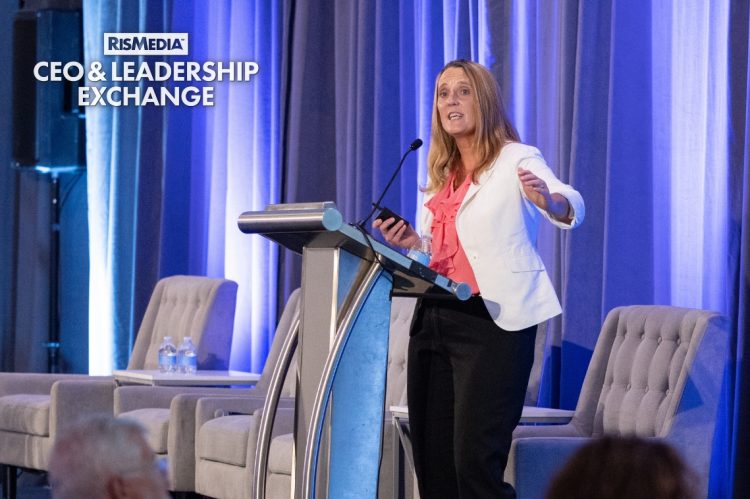Above: Bright MLS Chief Economist Dr. Lisa Sturtevant. Photo by AJ Canaria.
In 1992, pundit James Carville coined the phrase “It’s the economy, stupid!” As a soundbite, it was meant to illustrate that in politics, a good (or bad) economy is all that matters, urging political activists not to overthink their message or their fundamental focus.
In real estate, messages also tend to get overcomplicated, which can confuse both practitioners and consumers. In an energetic keynote on the current macro housing environment delivered at RISMedia’s CEO & Leadership Exchange earlier this month at the historic Mayflower Hotel in Washington, D.C., Bright MLS Chief Economist Dr. Lisa Sturtevant offered a similar call to keep things simple:
“Don’t let us forget the fundamentals—of demographics, of affordability and of economics,” she said.
In a year where housing has defied predictions and bucked conventional wisdom, the idea of keeping your focus on the fundamentals resonated at the event, as C-suite executives and thought leaders gathered to plot out the future of their businesses. After multiple years of dire predictions that have mostly failed to manifest, and blaring headlines have pushed a narrative of unprecedented and unpredictable change, there was less appetite for this kind of rhetoric—at least among those who have run a real estate business through these times.
Sturtevant was not alone among real estate economists offering a new perspective at the event. National Association of REALTORS® (NAR) Chief Economist Dr. Lawrence Yun also addressed attendees, and while admitting that this market is “very, very unique,” he argued that the usual factors were still dictating the path of housing.
“I usually have two ingredients in my models—mortgage rates and jobs,” he said. “This time we have a third variable, which is inventory.”
Perhaps the most unique aspect of this market is just how much attention—and confusion—is propagating around real estate. Anywhere Brands and Anywhere Advisors President and CEO Sue Yannaccone, in her own keynote, highlighted specific and often conflicting mainstream media headlines, making the point that it is impossible to make sense of real estate this way.
While both Yun and Sturtevant acknowledged that some historically unprecedented factors had roiled the industry over the last couple of years, markets are still resting on the fundamentals that they always have—something that both consumers and real estate practitioners need to remember.
“If you were to pull up your Excel spreadsheet and run a little correlation, you would find that home sales go down when mortgage rates go up,” Sturtevant said. “If you didn’t pull out your Excel, and you just used some logic, you would also know that home sales go down when mortgage rates go up.”
None of that is to say that predicting the path of housing is easy, or that the last couple years haven’t defied some long-held beliefs in real estate. From an economist’s perspective, though, today’s market (and tomorrow’s) shouldn’t be viewed as some brave new world.
“Every housing cycle is unique,” Yun noted.
Death and taxes
After covering some of the more common metrics, and offering the prediction of mortgage rates falling by next spring at the latest, Yun asked the audience to consider a few numbers that likely don’t show up on the average real estate market report.
“Over a two-year timespan, 7 million new babies (were born) in the country,” he said. “Where are they sleeping—in the kitchen? There are 7 million Americans who turned 65, the traditional age of retirement. Why are they not listing their home?”
While remote work, mortgage rates and new proptech have all had their effects, Yun and Sturtevant both pointed to these deeper demographic and economic realities that are really driving housing markets. As long as people are working, aging and forming relationships, houses will need to move.
And the data shows that people are doing these things as much as they ever have—far more than average, in some cases. According to Sturtevant, there are 7.8 million households occupied by someone 75 or older who owns their home free and clear.
“When we do monthly surveys of our subscribers in the Bright footprint…we’re seeing that the bulk of new listings coming onto the market are folks moving into assisted living, folks moving to nursing care, folks retiring, adult children handling estate sales,” she said.
Labor is another factor that trumps any of the more sensational pandemic changes. Yun pointed out that there are 4 million more people working now than there were the month before the pandemic. Additionally, a staggering 40 million people have switched jobs—something that often, but not always, precipitates the purchase or sale of real estate.
“Maybe they’re doing the long commute less frequently, two days a week or three days a week. But nonetheless, every time they have to do that long commute, they begin to think, ‘Am I in the right house?’” Yun claimed.
When thinking about your own business, or talking to wary consumers, these economic realities need to be front of mind. And though in the short term, those more volatile changes can appear like they are having a stronger effect on housing, these deeper economic currents will eventually assert their power.
Yun went as far as to say that based on things like labor markets and demographics, 2024 could surprise on the upside. He guessed that sales would rise “at least 10%,” as “pent-up sellers” begin to move based on life events.
“There is some cost involved, some financial cost involved to make that move, but we have to make the move. The baby cannot sleep in the kitchen,” he reminded the audience.
Sturtevant looked further into the future, as well as further into the past, to make an argument that housing markets were both still healthy, and still moored to rational, predictable developments.
Right now, 25 – 34-year-olds have a lower rate of homeownership than at almost any other time period, she said. That is an extremely strong indication that demand is going to remain strong by those millennials (and older zoomers) who are forming families and growing their incomes.
To reach the same homeownership rate as boomers had in 1990, 621,000 young people will need to buy homes. Sturtevant said this explains why demand has persisted against mortgage rates and inventory issues.
“They’re starting to get married, they’re starting to have kids, but oh, by the way, they’re also not waiting to get married and have kids. They’re buying without that,” she noted. “Understanding that there’s still some pent-up demand there is really important.”
Again, these factors are at least somewhat independent of the short-term financial distress caused by mortgage rates, inflation or remote work, and as these pandemic-era fluctuations fade, it is these metrics that will still be used to track and predict housing.
The big short
Real estate is still a game that must be won today. Even speaking to an audience that has already proved they are well-positioned to thrive through the unpredictable and unprecedented short-term fluctuations of 2020-23, Yun and Sturtevant said there are still some potential surprises ahead—both good and bad.
Yun opened his address by highlighting Warren Buffett’s recent all-in on homebuilder stocks, which he said is a great illustration of the potential the market sees in new constructions.
“The gains that the builders have seen so far is not just the ending; it is just the beginning of more growth,” he said.
Sturtevant pointed out that seasonality had essentially vanished during the pandemic. When it returns—or whether it returns at all—is an open question still.
“I don’t know if this is a good thing or a bad thing, maybe it’s good, maybe it’s bad depending on how you like to run your business,” she said. “Now July is the new March or April.”
Another important distinction regarding remote work—as mainstream media continues to report on big companies and national trends, it is local geography that matters the most when it comes to job flexibility. Sturtevant pointed out that even comparing major metros, there are huge differences in the degree of work-from-home opportunities, largely dictated by the industries located there.
Data from Bright’s footprint has already demonstrated that these local trends can change how home price, availability and sales relate to distance from a city center, Sturtevant said. And knowing your region’s labor market is the best way to know how these factors will evolve—whether remote work and exurbs are likely to get hot or cool off in the coming years.
“When you’re thinking about what markets to focus your company’s business on…when you’re thinking about which local sub-markets are going to be really in demand, it’s really important to understand how your local economy differs from other places,” Sturtevant argued.
Another short-term goal that has gained new traction recently: NAR’s efforts to lobby for some capital gain tax relief, which could relatively quickly bring new inventory onto the market.
“You tell (buyers) that you buy a home, you sell your home, that’s your profit. You don’t have to worry about it,” Yun said.
Rates were also addressed, with both Yun and Sturtevant declining to do much “Fed watching” in their addresses—something that has become almost a hobby for some real estate practitioners. Briefly, Yun said he thought the central bank would realize the world economy was still “wobbly” and would begin cutting rates in the first half of next year, while Sturtevant said another rate hike at this month’s Fed meeting was “pretty likely.”
More important than “Fed watching” for brokers looking to prepare for the years to come is really zeroing in on the things that haven’t changed—or have changed in more fundamental ways—particularly when talking about inventory and affordability.
Facing some of the most experienced and successful real estate business leaders in the country, Sturtevant flipped the question on her audience.
“We need to think about what a typical housing market is going to be in the future. This is a question (where) I’d love to hear what you guys think, how you guys think we should be measuring what a balanced market is,” she said. “We haven’t been at a ‘balanced market’ since 2006.”












